Radio KCID
The novel also features an unconventional DJ, called Radio KCID, a science-fictional portrait of one of Jeter's friends, Philip K. Dick (the call sign is an anagram of DICK). [4] KCID is an old man living in Rattown, a future L.A. slum; he has a small portable transmitter, which turns him into a mobile radio station. He mostly plays old records of German opera such as Alban Berg's Wozzeck , an important element of the novel, but he also broadcasts pieces of news which mainstream media do not want to broadcast.
The novel is heavily indebted to the counterculture of the 1960s. "[KCID] had some sort of process worked out, an oracle or something. It had to do with randomly generated numbers—he had a little box, a minicomputer that lit up with seven- or eight-digit figures, I think. He told me when he had enough data worked into the system he could predict any series of events connected to Adder, a few minutes before each event actually occurred..." [1] : 131 This is a hint at I Ching , the Chinese oracular book Dick used to compose his 1962 novel The Man in the High Castle , but also a popular reading in the counter-cultural 1960s.
In Dr Adder music does not only have an aesthetic value. KCID plays Wozzeck, then he begins to interpret the opera by applying it to the situation of his listeners. "Hohl, alles hohl! That's the way it is, all right. Isn't that what you were just thinking? Ein Schlund, a gulf, an abyss, yawns beneath us and what can we do, friends? Some of us wait all our lives for something...". [1] : 135–135 This rambling monologue closely resembles those of freeform radio DJs.
Radio KCID has something else in common with counter-cultural radio: "All his broadcast equipment and tapes could fit into a suitcase—he could be anywhere in the slums with it now". [1] : 135–138 Such a mobile pirate radio is not science-fictional at all, since true underground radio existed in the 1960s in the form of illegal stations.
At the end of the novel KCID puts the microphone in front of the protagonist, Dr. Adder, so that he may speak to his "old fans, and everyone else, who never worshipped [him]". [1] : 246 It might be simply considered as a moment when a speaker is interviewing a celebrity—be it transgressive, underground, unconventional or not—but it can also be seen as a moment when a listener of Radio KCID (and Dr. Adder is also one of KCID's listeners) is given the opportunity to talk to "people clustered around the radios, waiting to hear [him]". [1] : 246 KCID probably expects that a political message will be delivered to the audience; while probably Adder's message will not be political at all, being the expression of a very personal rage. [1] : 214

Kevin Wayne Jeter is an American science fiction and horror author known for his literary writing style, dark themes, and paranoid, unsympathetic characters. He has written novels set in the Star Trek and Star Wars universes, and has written three sequels to Blade Runner. Jeter also gained recognition for coining the term "steampunks."

Philip Kindred Dick, often referred to by his initials PKD, was an American science fiction writer. He wrote 44 novels and about 121 short stories, most of which appeared in science fiction magazines during his lifetime. His fiction explored varied philosophical and social questions such as the nature of reality, perception, human nature, and identity, and commonly featured characters struggling against elements such as alternate realities, illusory environments, monopolistic corporations, drug abuse, authoritarian governments, and altered states of consciousness.

A Scanner Darkly is a science fiction novel by American writer Philip K. Dick, published in 1977. The semi-autobiographical story is set in a dystopian Orange County, California, in the then-future of June 1994, and includes an extensive portrayal of drug culture and drug use. The novel is one of Dick's best-known works and served as the basis for a 2006 film of the same name, directed by Richard Linklater.
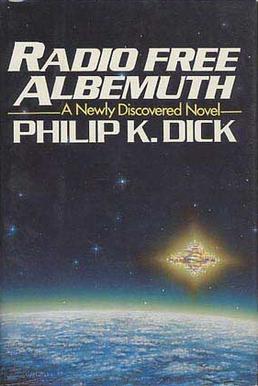
Radio Free Albemuth is a dystopian novel by Philip K. Dick, written in 1976 and published posthumously in 1985. Originally titled VALISystem A, it was his first attempt to deal in fiction with his experiences of early 1974. When his publishers at Bantam requested extensive rewrites he canned the project and reworked it into the VALIS trilogy. Arbor House acquired the rights to Radio Free Albemuth in 1985. They then published an edition under the current title, prepared from the corrected typescript given by Dick to his friend Tim Powers.

The Man in the High Castle (1962), by Philip K. Dick, is an alternative history novel wherein the Axis Powers won World War II. The story occurs in 1962, fifteen years after the end of the war in 1947, and depicts the political intrigues between Imperial Japan and Nazi Germany as they rule the partitioned United States. The titular character is the author of a novel-within-the-novel entitled The Grasshopper Lies Heavy, itself also an alternative history of the war.

Dangerous Visions is a science fiction short story anthology edited by American writer Harlan Ellison and illustrated by Leo and Diane Dillon. It was published in 1967.

Valis is a 1981 science fiction novel by American writer Philip K. Dick, intended to be the first book of a three-part series. The title is an acronym for Vast Active Living Intelligence System, Dick's gnostic vision of God. Set in California during the 1970s, the book features heavy auto-biographical elements and draws inspiration from Dick's own investigations into his unexplained religious experiences over the previous decade.

David Rowland Langford is a British author, editor, and critic, largely active within the science fiction field. He publishes the science fiction fanzine and newsletter Ansible, and holds the all-time record for most Hugo Awards, with a total of 29 wins.
Matt Howarth is an American comic book writer/artist known for such series as Those Annoying Post Bros, Savage Henry, Star Crossed, and Bugtown.
"A Little Something for Us Tempunauts" is a science fiction short story by American writer Philip K. Dick. It was first published in the anthology Final Stage in 1974.
"The Exit Door Leads In" is a science fiction short story by American writer Philip K. Dick. First published in 1979.
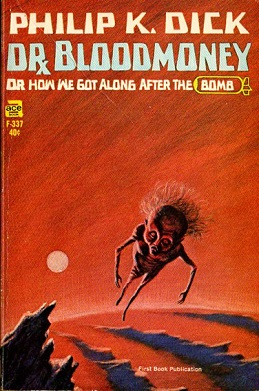
Dr. Bloodmoney, or How We Got Along After the Bomb is a 1965 science fiction novel by American writer Philip K. Dick. It was nominated for the Nebula Award for Best Novel in 1965.
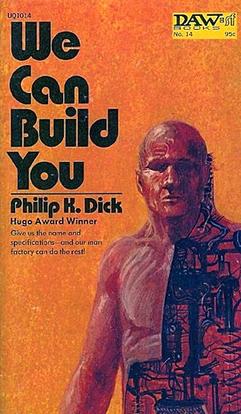
We Can Build You is a 1972 science fiction novel by American writer Philip K. Dick. Written in 1962 as The First in Our Family, it remained unpublished until appearing in serial form as A. Lincoln, Simulacrum in the November 1969 and January 1970 issues of Amazing Stories magazine, re-titled by editor Ted White. The novel was issued as a mass market paperback original by DAW Books in 1972, its final title provided by publisher Donald A. Wollheim. Its first hardcover edition was published in Italy in 1976, and Vintage issued a trade paperback in 1994.

The Unteleported Man is a 1966 science fiction novel by American writer Philip K. Dick, first published as a novella in 1964. It is about a future in which a one-way teleportation technology enables 40 million people to emigrate to a colony named Whale's Mouth on an Earth-like planet, which advertisements show as a lush green utopia. When the owner of a failing spaceship travel firm tries to take the 18-year flight to the colony to bring back any unhappy colonists, powerful forces try to stop him from finding out the truth.
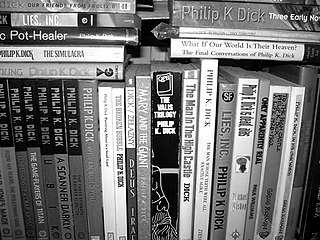
The bibliography of Philip K. Dick includes 44 novels, 121 short stories, and 14 short story collections published by American science fiction author Philip K. Dick during his lifetime.

Gather Yourselves Together is an early novel by the science fiction author Philip K. Dick, written around 1948–1950, and published posthumously by WCS Books in 1994. As with many of his early books which were considered unsuitable for publication when they were first submitted as manuscripts, this was not science fiction, but rather a work of straight literary fiction. The manuscript was 481 pages in length. At the time it was published, it was one of only two Dick novels for which the manuscript was known to exist which remained unpublished. The other, Voices from the Street, was published in 2007.

Voices From The Street is an early realist novel by American science fiction author Philip K. Dick, written in the early 1950s. Unpublished at the time, it was released on January 23, 2007, by Tor Books for the first time.
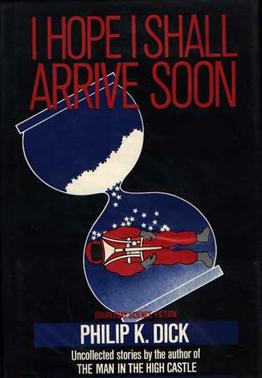
I Hope I Shall Arrive Soon is a book by American writer Philip K. Dick, a collection of 10 science fiction short stories and one essay. It was first published by Doubleday in 1985 and was edited by Mark Hurst and Paul Williams. Many of the stories had originally appeared in the magazines Fantasy and Science Fiction, Worlds of Tomorrow, Amazing Stories, Interzone, Rolling Stone College Papers, The Yuba City High Times, Omni and Playboy.

Venus on the Half-Shell and Others (ISBN 978-1-59606-128-6) is a collection mostly of science fiction author Philip José Farmer's pseudonymous fictional-author literary works, edited by Christopher Paul Carey and published in 2008. Farmer describes a fictional-author story as "a tale supposedly written by an author who is a character in fiction." Carey, who had access to Farmer's correspondence while editing the book, reveals in his introduction that in the early to mid-1970s Farmer planned to edit an anthology of fictional-author stories by other writers. Farmer solicited fictional-author stories from authors such as Arthur Jean Cox, Philip K. Dick, Leslie Fiedler, Ron Goulart, Howard Waldrop, and Gene Wolfe, urging them to submit their stories to venues such as The Magazine of Fantasy and Science Fiction. Only Cox, Waldrop, and Wolfe completed their stories and had them published, although Philip K. Dick's never realized fictional-author story "A Man for No Countries" as by Hawthorne Abendsen is said to have led Dick to write his posthumous novel Radio Free Albemuth. In the end, Farmer's fictional-author anthology never materialized.
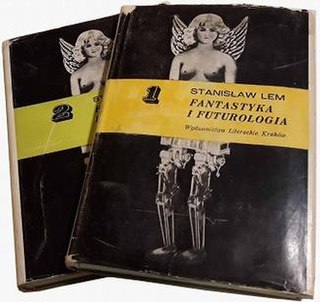
Science Fiction and Futurology is a monograph of Stanisław Lem about science fiction and futurology, first printed by Wydawnictwo Literackie in 1970.

















